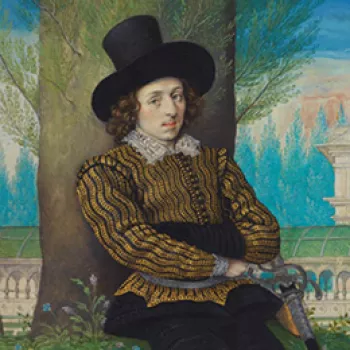Tapestry of a pergola 1640-60
Woven silk and wool tapestry | 302.0 x 381.0 cm (whole object) | RCIN 28029

Jacob Wauters (d. 1660)
Tapestry of a pergola 1640-60


-
Flemish tapestry of a double pergola of six columns with Corinthian capitals standing on a carved stone plinth. The coloumns support stems of vines, whose leafy branches form an arbour overhead. Two ornate vases filled with flowers stand on the plinth. Border of twisted columns on either side, the top with cornucopia and central cartouche with landscape. Woven in the workshop of Jacob Wauters. Similar designs are at the Sanctuary and the Deanery at Westminster Abbey.
On the other hand, the Duke of Lauderdale when Royal Commissioner between 1669 and 1673 had amongst his furniture there "Eight piece of arras pillar hangings lyned". These may have been loaned for the visit of the Duke of York in 1679. An understandably popular and decorative series, versions of these trompe l'oeil garden tapestries were woven at many centres: Brussels, Gobelins and Mortlake. The Holyrood panels were attributed to Mortlake until the weaver's mark was identified.
In this signed tapestry, a vine-covered double pergola provides the design framework, with its reeded pillars supporting an arbour hung with grapes overhead. Two large urns (‘Flower potts’) are filled with flowers of the expensive, florists’ sort: tulips, crown imperials and narcissi. This design gave weavers the opportunity to depict in wool and silk the same prestigious and exotic plants that were favoured in floral still-life paintings on canvas. The tapestries proved extremely successful; Wauters’s agents in London and throughout Europe distributed them to a wide market, and variations of the design were woven in Brussels and London, as well as Antwerp
This ‘flower potts’ design did not originate with Wauters, but was instead a commercially successful variant of a much earlier theme, re-presented for a richer horticultural era. The origin of this type lay in a magnificent series of Antwerp ‘garden’ tapestries bought by the Emperor Charles V in 1546, which depicted the narrative of Vertumnus and Pomona against a background of vine-laden pergolas. Ovid’s tale of Vertumnus and Pomona recounted the tale of the wooing of Pomona, goddess of fruit trees, gardens and orchards, by Vertumnus, god of the seasons. In his effort to woo Pomona, Vertumnus adopted various disguises and, according to Ovid: ‘Sometimes, knife in hand, he was a vineyard worker, pruning leaves and vines, or he took a ladder on his shoulder so that you would think he was expecting to pick fruit’. The narrative was set conventionally against a garden background, but Vertumnus’ disguise as a viticulteur provided the rationale for bringing the vine-clad pergola to the fore in this set of woven images. Further tapestry sets made in Brussels elaborated this theme in the late sixteenth century, before it was revived again by Wauters and other manufactories in the midseventeenth century.
Text adapted from Painting Paradise: The Art of the Garden, London, 2015.Provenance
In the Duke of Hamilton's Apartments, Holyroodhouse before 1906. Confirmed property of King Edward VII in 1906.
-
Creator(s)
(tapestry manufacturer)(nationality)Acquirer(s)
-
Medium and techniques
Woven silk and wool tapestry
Measurements
302.0 x 381.0 cm (whole object)
Category
Object type(s)
Place of Production
Antwerp [Belgium]








